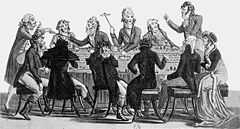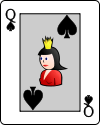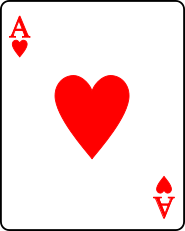Three card brag
 | |
| Origin | English |
|---|---|
| Alternative name(s) | Brag |
| Type | Gambling |
| Players | 4–7 |
| Skill(s) required | Counting |
| Cards | 52 cards |
| Deck | Anglo-American |
| Play | Anti-clockwise |
| Playing time | 5-10 min. |
| Random chance | Medium |
| Related games | |
| Teen Patti, Poker | |
Three card brag is a 16th-century British card game, and the British national representative of the vying or "bluffing" family of gambling games.[1] Brag is a direct descendant of the Elizabethan game of Primero[2] and one of the several ancestors to poker, just varying in betting style and hand rankings.
The game is very popular in Trinidad, India, Bangladesh and Nepal, where it is known both as "Flush" and "Teen Patti" (literally "three cards" in Hindi), played with some minor variations. At large gatherings and especially during festival times, it is the game of choice since many people of different skills can play together and have fun. It is also a very popular game among British fairground showmen, who usually get together at the bigger fairs and play for quite high stakes.
Rules
Everyone antes, and players are each dealt three cards face down. There is a single round of betting, with action starting to the left of the dealer. Each player has the option of betting or folding. If there was a previous bet, the player must contribute at least that much more to the pot. (Unlike usual poker betting, your previous money contributed to the pot is ignored.) This betting continues until there are only two players left, at which point either player may double the previous bet to "see" his opponent. At this point, the two hands are revealed, and the player with the better hand takes the entire pot. If there is a tie, the player who is seeing loses.
For example, with four players A, B, C and D, this situation could occur: Player A bets 2 chips, B folds, C bets 2 chips and D bets 2 chips. In order to stay in, A would have to bet another 2 chips (at least).
Variations
- Four Card Brag: Players are dealt four cards, and must then choose which card to throw away (place at the bottom of the deck) in order to create the best combination. The game is then played in the same way as Three Card Brag.
- Seven Card Brag: Seven cards are dealt, players must choose three cards to play from their hands, or make two hands, with only a successful winning of both hands winning the pot.
- Nine Card Brag: Nine cards are dealt, players sort these into three sets. Four antes are played, one for each set, and a main pot. Each set is then played out, usually without further betting. The winner of each set takes one lot of antes; if a player wins all three sets they receive the main pot as well, otherwise it remains for the next hand. Players must always play the next best available set they have made. Often a player may be able to make two good sets and a poor third (e.g. prial, straight, ten-high), so players that do not think they will be able to win all three will order their hands to leave themselves with a strong third set to protect the main pot.
- Thirteen Card Brag: Thirteen cards are dealt, from which players must choose three cards to play. Another variation involves making four hands (or the most possible over a certain standard) from the thirteen cards. Four of a kind can also be played, and is usually rewarded by an additional fee to be paid by the other players, apart from any original stake. Players then show their respective best hands, then second best hands, etc., with each winning hand scoring that player a point, or points. Score is kept on a cribbage board, and is usually either a sprint of 10 or so holes, with one point scored for each winning hand, or played over the full length, or street, of the board, with 4 points awarded to the best highest hand, 3 points to the best second-highest hand, etc. Players not on the board by the time someone wins may have to pay double. Winnings are either a pre-arranged fixed amount from each loser to the winner, or paid proportionate to how far behind the winner they finish. Any player winning all four hands in any round is said to have crashed, and automatically wins the entire game. In some regions the game is known as 'Crash'.
- Bastard Brag: Three cards are dealt to each player, and three face-up communal cards are dealt (in some versions only two are face up, one is face down). Players take turns at exchanging one or all (but not two) of their cards for any or all of the communal cards. Play continues until one player 'sticks', or 'knocks', meaning that they are happy with their hand. All the remaining players then exchange one last time before hands are compared. The player with the lowest hand is out, or loses a life.
- The name may originate from several of the rules making the player feel like cursing. Knocking on the first round is prohibited, forcing anyone dealt a good hand to break it up, knocking isn't allowed directly after an exchange, rather instead of an exchange, i.e. you have to make a good hand, and then wait for your next turn to stick. Players can't exchange two cards at once, perhaps preventing the immediate accumulation of a good hand, with the card needed to complete the hand maybe taken by another player before the next opportunity.
- Fifteen card Brag: A normally non-gambling related variant, played as a family game. Each player is dealt fifteen cards, from which they make five three card tricks. Each player must then lay their tricks down in order, highest first. The winner is the one who wins the most tricks. This variant has a much higher likelihood of more powerful tricks, due to the extra cards.
Some of these rules can also lead to games, especially heads-up, becoming tactical, with players avoiding making their best hand until their hand is forced into that last exchange by another player sticking, risking that the card that completes their hand isn't taken by another player in the meantime.
Hand ranks



Straight flush


Straight or Run


Flush


Pair


High card


The hand rankings, from best to worst, are: three of a kind ("prial"), straight flush ("running flush"), straight ("run"), flush, pair, high card. The best prial is 3-3-3, followed by the usual order of A-A-A, K-K-K, etc. In variations allowing four-of-a-kind, 4-4-4-4 is the best 'box', followed by A-A-A-A, K-K-K-K, etc. The best running flush or run is A-2-3, A-K-Q, followed by the usual order of K-Q-J,etc. The flushes, pairs, and high cards have rankings identical to poker (aces high).
A pair will beat three-quarters of hands, but must watch out for unexpected runs and flushes. Prials and running flushes are extremely rare but are more common in versions of the game in which a hand is chosen from more than three cards. Unlike in other forms of poker, a run beats a flush. Because of the mathematics involved, three card flushes are more likely than three card straights, while the reverse is true of five-card (poker) hands.
Betting blind
Players also have the option of playing blind (betting without looking at their cards). A blind player's costs are all half as much as an open (non-blind) player's. However, an open player may not see a blind player. If all other players fold to a blind player, the pot remains, everyone re-antes, and the blind player gets to keep his hand for the next round (in addition to the new one he is dealt). At any time, a player with two blind hands may look at one of them and decide whether to keep it or throw it away. If he keeps it, he throws away the other hand and is considered open. If he throws it away, he keeps the other hand and is still blind. If everyone folds to a blind player with two hands, he must throw away one without looking.
Shuffling
Another unusual custom of Brag is that the deck is rarely shuffled. Unless a hand is seen and won by a prial, the cards from the hand are just placed on the bottom of the deck, and the next hand is dealt without shuffling.
See also
References
External links
| Wikisource has the text of the 1911 Encyclopædia Britannica article Brag. |
- Detailed Rules for Brag by John McLeod
- The hand-book of games by H.G. Bohn at Google Books
| ||||||||||||||||||||||||||||||||||||||